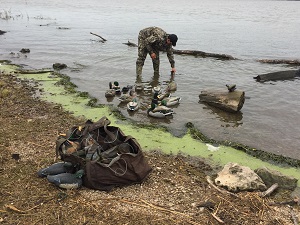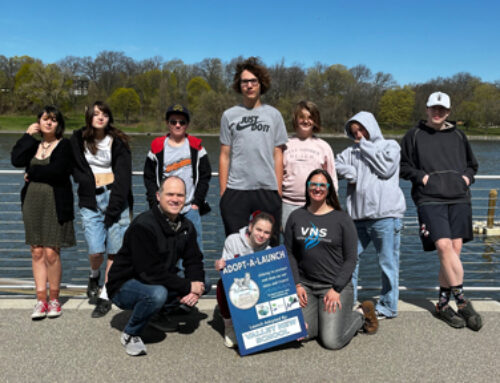Take An Extra 2 Minutes to Check Your Equipment and Protect Your Favorite Wild Places
The 2020 waterfowl hunting season is fast upon us in Northeast Wisconsin!
In the Southern and Mississippi Zones the main season opener is October 3rd. Northern Zone hunting for wild ducks begins September 26th. Since waterfowl hunters (like anglers) are often using boats, canoes and kayaks to access their hunting sites or hiking into wetlands, aquatic invasive species (AIS) prevention needs to be part of the hunting ritual.
Waterfowl hunters are a unique water user group with a real power to make a difference. By using artificial blind materials instead of plants, whether they  happen to be native or not, they can prevent seeds and plant parts that can easily root from spreading from location to location. Checking under a hunting dog’s vest can yield a surprising amount of seeds and tiny animals like snails that should be removed. Of particular concern to hunters is the Faucet snail. These snails carry intestinal flukes that can kill ducks if they eat them.
happen to be native or not, they can prevent seeds and plant parts that can easily root from spreading from location to location. Checking under a hunting dog’s vest can yield a surprising amount of seeds and tiny animals like snails that should be removed. Of particular concern to hunters is the Faucet snail. These snails carry intestinal flukes that can kill ducks if they eat them.
And what’s duck hunting without mud? So much mud that can end up on gear, dogs, waders and boats! Removing as much as possible helps lower the risk of moving invasive pests, such as purple loosestrife seeds, the bulbils of starry stonewort, and the eggs or larvae of tiny invaders, such as spiny water fleas.
Some of our project partners Bruce Ross (Executive Director of Wisconsin Waterfowl Association) and Chris Hamerla (AIS Coordinator for Golden Sands RC&D) worked with Amy Kowalski of UWSP Extension Lakes to create this great video for hunters, showing them in detail what they can do to Stop Aquatic Hitchhikers: Waterfowlers Can Help Prevent AIS.
In the Fox-Wolf watershed, Fox-Wolf staff and volunteers will be at popular boat launches used by waterfowl hunters. They will be talking with hunters about the importance of preventing the spread and introduction of aquatic invasive species. The prevention steps are easy to do and add less than 2 minutes to the end of your hunting day.
AIS Prevention Steps for Hunters
Before launching into and leaving a water body, hunters should:
- Inspect waders, boats, trailers, motors and hunting equipment, including boots, blinds, and dogs
- Remove all plants, animals, and mud to the best of their ability
- Drain all water from decoys, boats, motors, livewells and other hunting equipment
- Never move plants or live fish away from a water body
- A special consideration for waterfowl hunters is to remove all seed heads and roots when using vegetation for duck blinds. If you hunt in Brown, Calumet, Fond du Lac, Menominee, Outagamie, Shawano, or Winnebago Counties, you are allowed to use the stems of Phragmites for your blinds but be sure to remove all seed heads and roots.
For more information about aquatic invasive species, including where they are prohibited and restricted in Wisconsin, search dnr.wi.gov for keyword “invasives.”
Questions? Comments? Contact Chris Acy, the AIS Coordinator covering Brown, Outagamie, Fond du Lac, Calumet, and Winnebago Counties at (920) 460-3674 or chris@fwwa.org! Anna Bartsch is the AIS Coordinator covering Shawano and Menominee Counties and she can be reached at anna@fwwa.org or (920) 851-4336.
Follow the Fox Wolf Watershed Alliance’s Winnebago Waterways Program on our Winnebago Waterways Facebook page or @WinnWaterways on Twitter! You can also sign-up for email updates at WinnebagoWaterways.org.
Winnebago Waterways is a Fox-Wolf Watershed Alliance program. The Fox-Wolf Watershed Alliance is an independent nonprofit organization that identifies and advocates effective policies and actions that protect, restore, and sustain water resources in the Fox-Wolf River Basin.







